Introduction
It’s time to pull together. Water policymakers have managed to successfully perpetuate a status quo and lay blame for zero salmon on boats this year solely at the cracked feet of drought. It’s not a hard sell, either. Cities across the State are consistently sending mailers to residents to reduce their water usage. Our highways are peppered with real-time traffic signs displaying messages to “Save our Water.” It’s a memo that’s simply ubiquitous if you live in California. Don’t get me wrong, drought’s an issue, a serious issue. But so are the State’s actions during periods of water shortages – especially when those diversions reduce flows in our rivers or drive temperatures to lethal levels for salmon eggs.
Let’s not kid ourselves, droughts will return and when they do we need to be ready to ensure salmon have water so fishermen and women have a livelihood, businesses have customers, people have a sustainable food source, and ecosystems are fully functional. I’m ready to praise the Governor for solid actions that benefit the salmon fishery just as much as I’m poised to callout the administration on continued shortfalls – failures in providing healthy temperatures and flows to our salmon bearing rivers, which directly caused our 2023 ocean and in-river closures.
But we can’t do this alone. And we certainly can’t let the news cycle sunset the salmon crisis or get distracted by a bit of positive, but minor, salmon project sleight of hand by the Governor that won’t actually move the fish on boats needle. It’s up to us, all of us, to strengthen our voices, take a page from the State’s communications playbook, and deliver the salmon and water crisis message to everyone…constantly. Salmon need water so let’s fight for it, together.
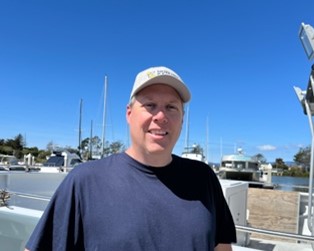
Scott Artis
Executive Director
Golden State Salmon Association
GSSA Releases Emergency Salmon Recommendations as Closure Hits In-River Salmon Fishing
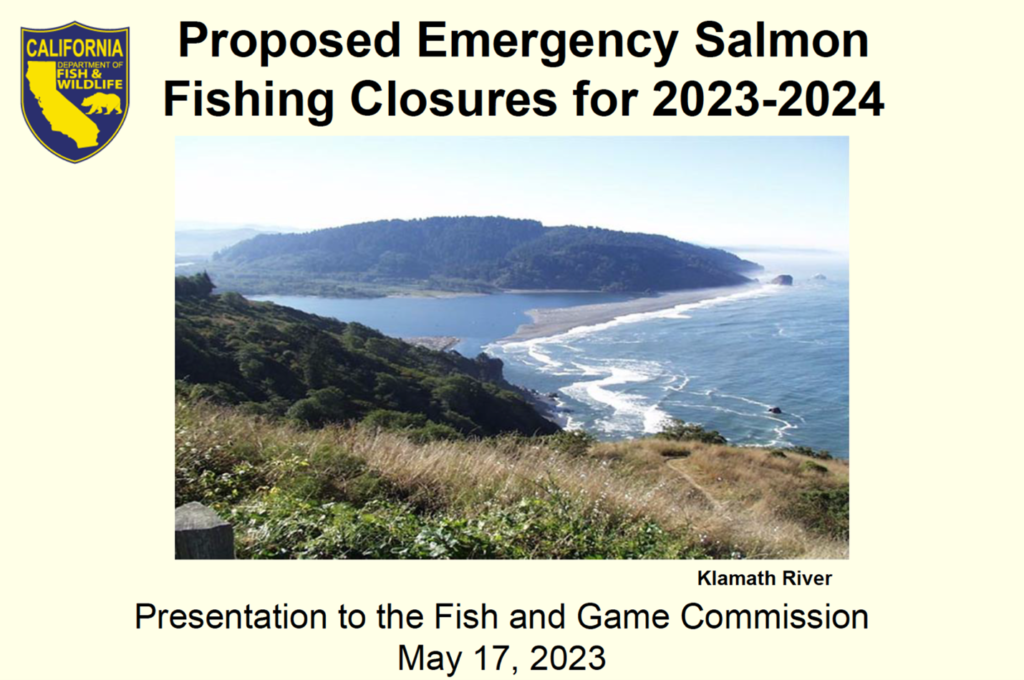
California Fish and Game Commission unanimously adopted, on May 17, 2023, emergency regulations for Chinook salmon recreational fishing closures for the Klamath River, Trinity River, Eel River and Smith River due to federal salmon closure recommendations. The adoption of this closure included an exception for federally recognized Tribes.
Citing multiple causes including low flows that have led to a significant decline of California Chinook salmon stocks, and the Pacific Fishery Management Council’s recommended closure of 2023 California salmon fisheries in April, the California Department of Fish and Wildlife (CDFW) proposed temporary emergency salmon fishing closures and cited a need for emergency regulation at today’s California Fish and Game Commission meeting. CDFW reported to the Commission that salmon stocks in the West are in decline with 2023 Sacramento River fall Chinook and Klamath River fall Chinook ocean abundance forecasts at the 3rd lowest on record and early adult return data from spring Chinook in Mill, Deer and Butte creeks are extremely low.
“This latest closure of our inland waters salmon fishing is a devastating reminder that California’s poor water policy impacts real people, real families, real businesses, real communities, and a keystone species people and wildlife rely on. And it’s not going away until we enact real solutions,” said Scott Artis, Executive Director of Golden State Salmon Association (GSSA). “In response to the 2023 salmon season closure, Golden State Salmon Association has developed and released recommendations for action at the state level, which are focused on the cause of the current salmon collapse – lethally low river flows and high water temperatures.”
The Central Valley Salmon Emergency Recommendations released by GSSA call for the State Water Board to adopt and enforce specific, science-based and legally enforceable flow requirements for the Bay-Delta and its tributary salmon rivers, as well as requirements to ensure safe temperatures for salmon below Shasta Dam on the Sacramento River. The recommendations also call for the State to stop waiving flow requirements, stop issuing new Bay-Delta water rights, renegotiate antiquated water contracts, improve temperature conditions on the Feather River, and expand access to cold water habitat.
“Over the long-term, other actions will be required to restore fully healthy salmon runs. And to complement our state actions, we are also working on federal and hatchery recommendations to aid salmon recovery. In the short-term, however, we must stop killing salmon in Central Valley rivers through inadequate flow and temperature conditions,” said Artis. “Droughts have always caused some impacts on California salmon runs. However, salmon have survived droughts for millennia and remained abundant. The core of the crisis Central Valley salmon and the fishing economy face today is how we manage our water resources. This mismanagement has turned our rivers into death traps for salmon.”
Currently, California’s salmon industry is valued at $1.4 billion in economic activity and 23,000 jobs annually in a normal season, and contributes approximately $700 million to the economy and supports more than 10,000 jobs in Oregon. Industry workers benefiting from Central Valley salmon stretch from Santa Barbara to northern Oregon. This includes commercial fishermen and women, recreational fishermen and women (fresh and salt water), fish processors, marinas, coastal communities, equipment manufacturers, the hotel and food industry, tribes, and others.
Golden State Salmon Association’s Central Valley Salmon Emergency Recommendations: Actions Needed at the State Level can be downloaded at: https://drive.google.com/drive/folders/15IUWKJm67yKaVi9M-E43t9uXAupA86me?usp=sharing
Central Valley Salmon Near-Term Hatchery Recommendations Delivered to CA Senator, CA Agencies
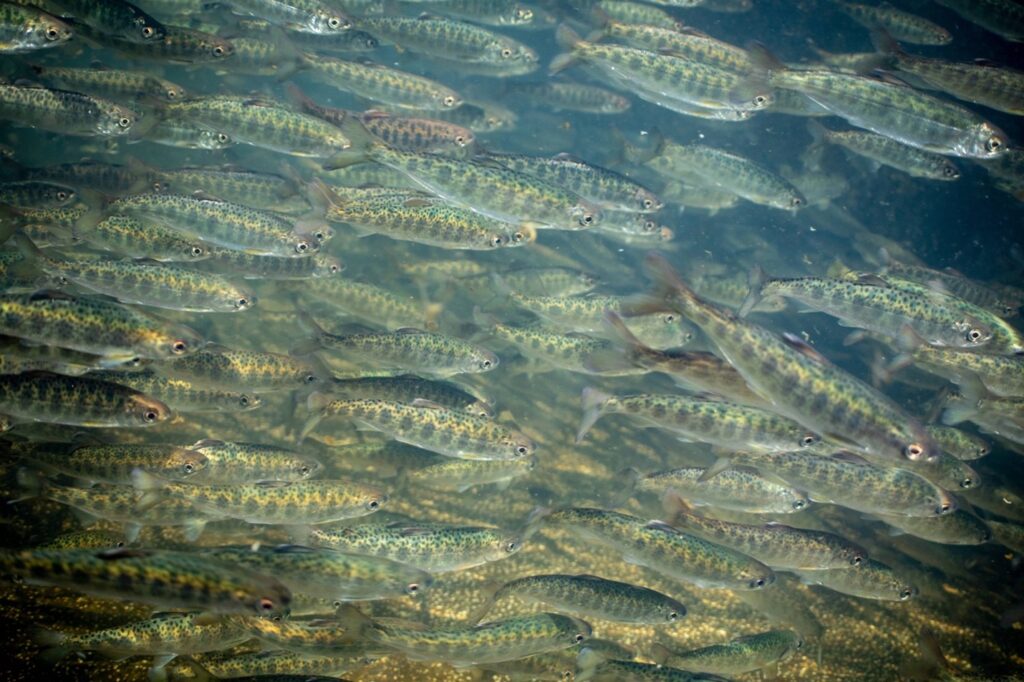
In addition to our recommendations on flow and temperature issues, Golden State Salmon Association urged short-term actions needed at the State level to improve hatchery management during May meetings with the office of CA Senator Mike McGuire, and Secretary Wade Crowfoot (California Natural Resources Agency), Secretary Yana Garcia (California EPA), and Director Chuck Bonham (CDFW). These near-term actions will be followed by a longer-term hatchery plan.
Increase Feather River Fry Production and Releases: The Nimbus Hatchery’s current 1 million fry releases should continue. Feather Hatchery production should be increased, with those additional fish released as fry. Work with CDFW to develop an aggressive near-term target for increased Nimbus and Thermalito production.
Bring the Thermalito Annex Hatchery Back on Line: This currently dormant
hatchery could help increase fry production, and should be modified to ensure
that it is raising salmon in Feather River water. Unless released as fry, juvenile fish from this facility should be trucked to a release point in the West Bay.
Accelerate Parentage Based Tagging: A significant investment in Parentage Based
Tagging (PBT) is likely required in order to increase fry releases. An analysis of the cost to upgrade PBT (e.g. an expansion in the current laboratory and staffing) should be included in the $17 million for hatcheries in the 22-23 FY budget. GSSA’s flow and temperature recommendations include $250 million for salmon restoration actions in the next water/climate/resources bond – including funding for dam removal and reintroduction programs. GSSA recommends bond language be written so that it could fund needed hatchery upgrades, such as chillers, water treatment and production expansion.
Increase Mokelumne Hatchery Production: Mokelumne Hatchery production should be increased in the near-term by 1.5-2 million fish – the maximum capacity of the current hatchery facilities. Although Mokelumne production does not count toward the Sacramento Index, once the season reopens it’s among the most efficient ways to generate fish for the commercial and recreational salmon fishing communities.
GSSA Welcomes New Regional Administrator for NOAA Fisheries West Coast Region – Discusses Protecting Fall Run Chinook
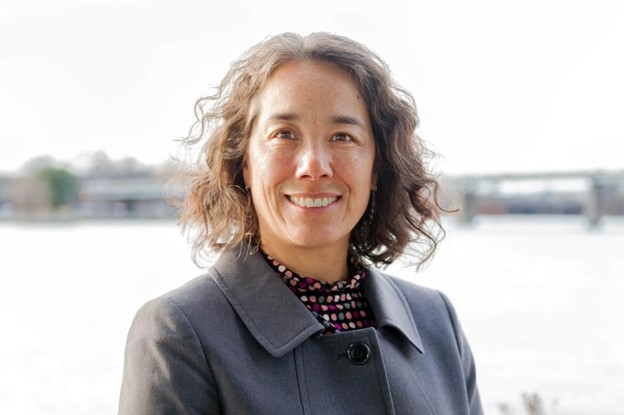
On May 11, Golden State Salmon Association and partners NRDC and Defenders of Wildlife met with Jennifer Quan, NOAA Fisheries’ new Regional Administrator for the West Coast Region, to advocate for a National Marine Fisheries Service leadership push for measures by the State Water Resources Control Board to protect our critical fall-run salmon. GSSA urged improving Shasta temperature management and increasing flows into and through the Delta in the updated Bay-Delta Water Quality Control Plan. Additionally, GSSA informed Quan that for a decade, California water agencies have promised a comprehensive voluntary agreement to address the deteriorating conditions in the San Francisco Bay-Delta estuary and Central Valley rivers, including declining endangered species, proliferating harmful algae blooms and damaged salmon runs. These voluntary agreement efforts are growing less promising over time. Recently, the process has:
• Been dominated by water agencies whose diversions are the major cause of the crisis.
• Emphasized “non-flow” actions rather than significant improvements in water flows in the estuary and its tributary rivers that the state’s analyses show are essential.
• Avoided incorporating the best peer-reviewed science regarding the Bay-Delta.
• Excluded most or all of the stakeholder groups harmed by ecosystem decline.
GSSA is looking forward to working with Jennifer Quan to help implement solutions that increase and restore the fall-run chinook salmon fishery.
2 Million Chinook Salmon Begin Ocean Journey – Released at Fort Baker, Sausalito
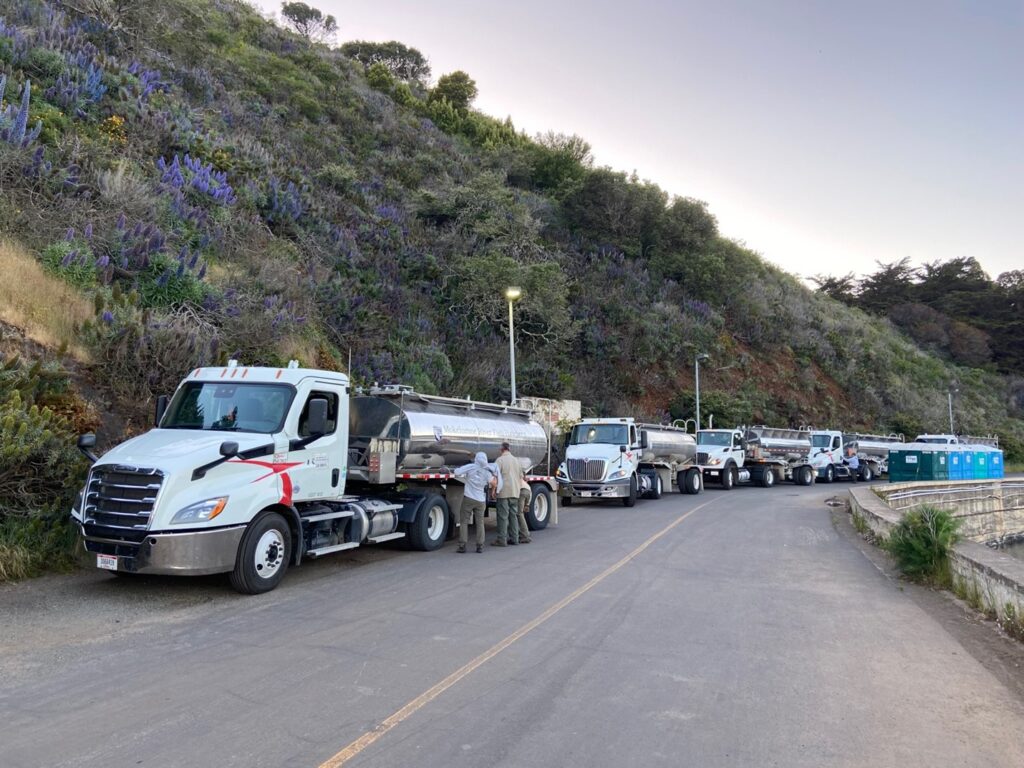
On May 13 and 15, the Department of Fish and Wildlife released approximately 910,000 brood year 2022 fall-run Chinook Salmon from Mokelumne River Fish Hatchery into the San Francisco Bay at Fort Baker. Another 1,100,000 fish were released on May 29 and 30, bringing the total to just over 2 million for the month. These fish were approximately 107mm fork length, Coded Wire Tagged and marked with an adipose fin clip at a rate of 25%.
The survival of these fish depends on where they’re released, which is why GSSA continues to work with state and federal governments to increase releases of hatchery salmon at Sausalito’s Fort Baker into the future. Under the current annual permit, CDFW can release up to 2 million fish at Fort Baker. GSSA originally asked for the increase in releases at this site, in part at the request of state fish and wildlife officials who appreciate the relationships GSSA has developed with key stakeholders.
Survival of fish released at Fort Baker is at least twice as good as the traditional release site near Vallejo and sometimes up to three times better.
GSSA Testifies Against Harmful Salmon Fishery Bill at the California Senate and Assembly Budget Subcommittees
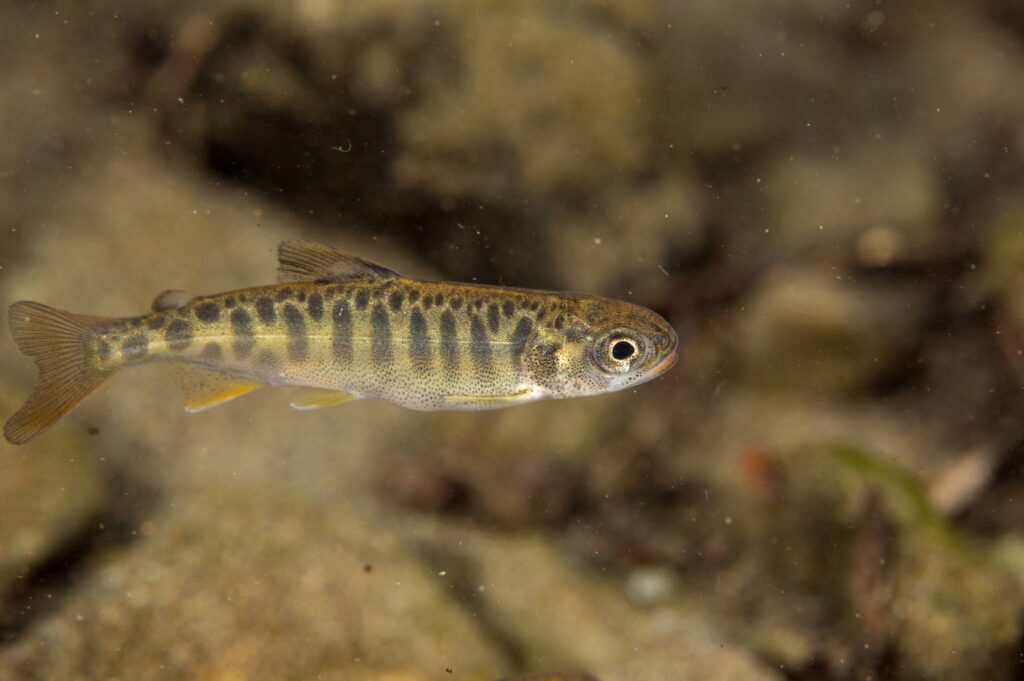
Expressing strong opposition to the Newsom Administration’s Drought and Flood Streamlining budget trailer, Golden State Salmon Association testified on May 16 and 17 at the California Senate and Assembly Budget Subcommittees.
This bill would dramatically reduce state regulation of diversions from California rivers during high flow periods. High river flows are essential to support California’s salmon runs during the juvenile outmigration period. Periods of high spring flows dramatically increase the survival of juvenile salmon. In fact, the lack of such high flows in many years is a major cause of the decline of salmon in the Bay-Delta watershed and elsewhere in the state. High flows also provide other important environmental benefits including supporting chemical, biological and physical processes such as maintaining water quality and facilitating sediment movement.
As a result of low populations of returning fall run Chinook adults, the 2023 California salmon fishing season has been closed for just the second time in state history. This human-made disaster has put thousands of Californians out of work and imposed severe hardships on fishing families and communities. In addition, the Central Valley winter and spring run Chinook salmon are both at risk of extinction. That risk is particularly acute for spring-run salmon. Initial counts of 2023 adult Central Valley spring run Chinook are catastrophically low.
GSSA believes the State of California should strengthen protections for salmon runs, not weaken them. The trailer bill includes a long list of serious flaws, including:
• No Protection of Flows Needed for Salmon: The bill does not include any requirement to distinguish high flows that are needed for the outmigration of salmon and the rebuilding of salmon runs, including listed and commercially important species, from truly excess flood flows. In fact, the State Water Board has never adopted a spring outmigration flow requirement to protect salmon, despite abundant evidence linking the decline of salmon to poor flow conditions.
• No Meaningful Salmon Screening Requirement: The bill requires “simple screens” to “minimize the impacts of diversion to salmon and other aquatic life.” Fish screens are sophisticated technology. Their effectiveness is driven by factors such as location in a river and approach velocities to keep fish from being pinned against the screens and killed. In addition, screens often fail to prevent the entrapment of juvenile or larval fish. Without a meaningful screening requirement, this provision might do little to protect salmon.
Governor Unveils $60-Million Yuba River Fish Passage – But What About Flows?
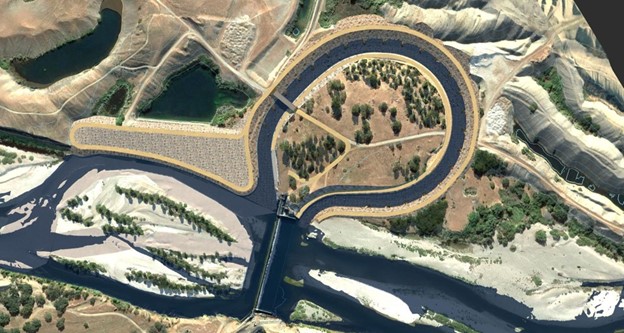
On May 16, Governor Newsom announced a plan to build a fish bypass to circumvent DaGuerre Point Dam, in Marysville, which will allow spring-run salmon and other species to access up to 12 miles of upstream spawning habitat. The proposed bypass is welcomed and encouraging for spring-run chinook, although removal of the dam would ultimately be best. The bypass also provides a pilot spring-run reintroduction project on the North Yuba River above New Bullard’s Bar dam, which has excellent habitat upstream. The Yuba River proposal is similar to the pilot reintroduction project on the McCloud River. Both of these are modest, positive projects, but the process, unfortunately, has excluded important stakeholders including nonprofits and tribes that were left out of discussions. More importantly, the agreement suggests that the State is trading this fish passage project for the possibility to include flows on the Yuba – making it difficult for the State Water Board to require more flows needed by salmon, unless the Yuba water Agency agrees.
“Saving salmon and improving their spawning and rearing habitat is critical for jobs, businesses, culture, communities and functional ecosystems. Non-governmental organizations working on the Yuba River were not included in recent talks leading to this agreement,” said Scott Artis, executive director of Golden State Salmon Association. “In principle, we support both passage around Daguerre Point Dam and reintroduction to the upper Yuba. But the details matter. The Newsom Administration has abundant additional opportunities to address the State’s salmon emergency by setting temperature and flow standards, ending the practice of waiving salmon protections, improving temperature conditions on the Feather River and forcing PG&E to pull salmon killing dams out of the Battle Creek watershed.”
Join Us and Step Up for Salmon
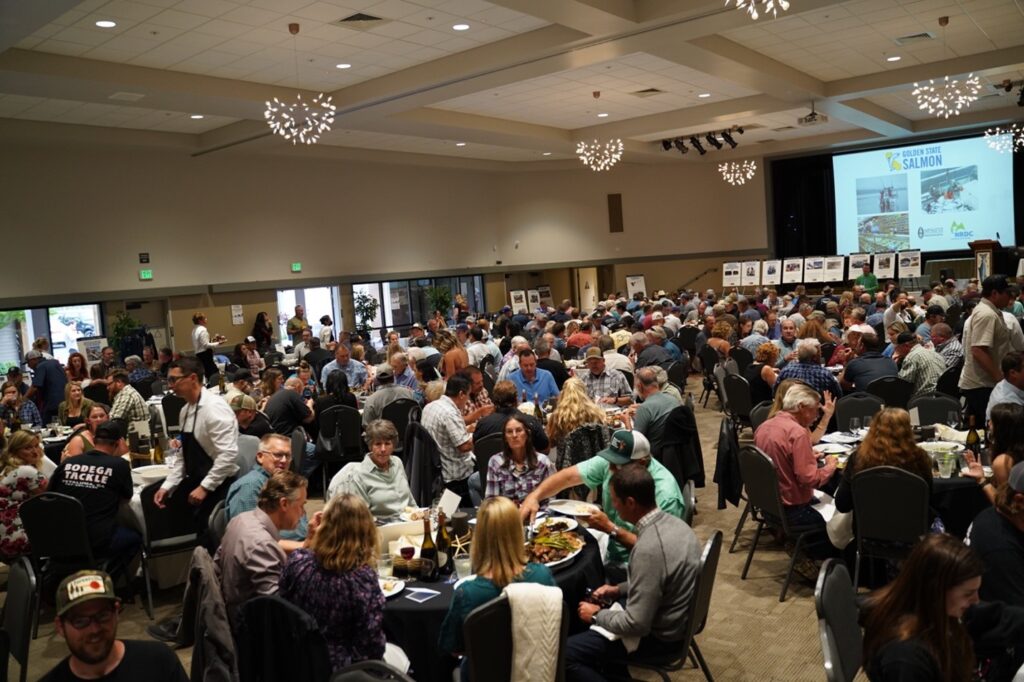
11th Annual Santa Rosa Dinner | Friday, June 2, 6pm
What are you waiting for? Mouthwatering BBQ, open bar, exciting auction and raffle prizes, and great company. It’s our biggest event of the year and not to be missed – raising the funds necessary to restore our critical California salmon runs. When we fight for salmon, we fight for individuals, families, businesses, jobs, wildlife and communities. We need you now more than ever. Get your tickets Today!
Renew Your GSSA Membership
Can’t make it to our Santa Rosa Dinner? Now’s the time to renew your GSSA membership or make a special contribution. When you contribute to Golden State Salmon Association, you play a key role in advancing restoration of salmon runs that is scientifically proven and results driven. Supporting our work is one of the most effective things you can do to protect California’s salmon for current and future generations.



